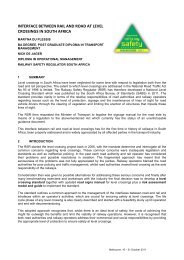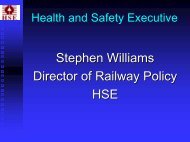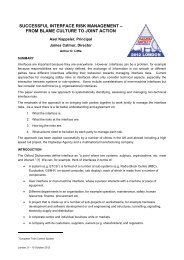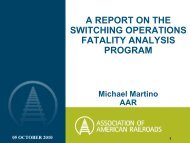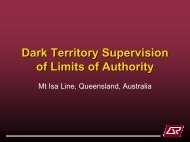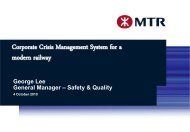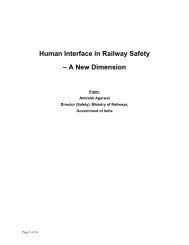Presentation - International Rail Safety Conference
Presentation - International Rail Safety Conference
Presentation - International Rail Safety Conference
Create successful ePaper yourself
Turn your PDF publications into a flip-book with our unique Google optimized e-Paper software.
Organisation and Cultural Impacts<br />
25th – 27th October 2004<br />
IRSC 2004, Perth, Australia<br />
ENSURING SECURE CROSS-BORDER<br />
OPERATION WITHOUT COMPROMISING<br />
SAFETY<br />
Johnny Restrup-Sørensen<br />
Director Of Infrastructure<br />
Øresundsbro Konsortiet<br />
Denmark & Sweden
Øresund fixed Link alignment
The Øresund bridge
Tunnel portal
Tunnel cross section
Bridge cross section
Two countries – two technologies<br />
Main differences between Swedish and Danish systems:<br />
• <strong>Safety</strong> regulations<br />
• Signaling<br />
• Automatic train protection<br />
• Catenary's voltage and frequency<br />
• <strong>Rail</strong> inclination<br />
• Train radio systems<br />
Other problems:<br />
• Different languages
<strong>Rail</strong>way language<br />
Long term:<br />
Short term:<br />
<strong>International</strong> railway language<br />
Danish & Swedish<br />
Important words: Swedish in Sweden and vice versa<br />
Simple words: Danish or Swedish<br />
Words to be pronounced distinctly and close to the<br />
way they are spelled<br />
Codes will be used e.g. To identify modes of operation<br />
of traction power
Cross-border train operation, the language<br />
Klart för<br />
avgång<br />
Færdigmelding<br />
“Ready for departure”
Signaling aspects<br />
Differences between Danish and Swedish signaling systems<br />
Denmark Sweden Norway<br />
Stop Stop Stop<br />
Proceed and expect Proceed with Drive from/to<br />
Stop at next signal high speed divergent track<br />
(low speed)<br />
Proceed and expect Proceed with Drive from/to<br />
1 green at next signal max. 40 km/h main track<br />
(high speed)
Two countries – two technologies<br />
System border<br />
Changes in one “point” (on the artificial island):<br />
• Signaling<br />
• Traffic management<br />
• Regulations<br />
• Radio system<br />
• Automatic train protection<br />
• Remote control of catenaries system
Interlocking Systems on the Fixed Link<br />
Concentrators<br />
DSB 1990<br />
Relay interface<br />
STLV85<br />
Danish Coast<br />
Peberholm<br />
Swedish Coast<br />
System border
Operating experience<br />
• Overall safety target met in full<br />
• No accidents or potentially dangerous situations<br />
• 81 incidents in 2001 versus 70 in 2002 and 71 in 2003<br />
‣ errors relating to rolling stock, e.g. trains with an<br />
erroneous intercommunication system or faulty<br />
mobile ATP-equipment<br />
‣ incorrect or inadequate safety reports between<br />
Danish and Swedish remote control centres or<br />
between the remote control centre and engine<br />
drivers<br />
‣ infrastructure errors, primarily signalling errors
The Øresund <strong>Safety</strong> Management System<br />
• Senior management commitment<br />
• <strong>Safety</strong> culture, policy & safety goals<br />
• <strong>Safety</strong> information<br />
• Hazard identification and risk management<br />
• Establishing a safety reporting system<br />
• <strong>Safety</strong> assessment/audit<br />
• Accident and incident reporting and investigation<br />
• Recurrent training
The basic safety process
Hazard identification techniques<br />
• Preliminary Hazard Analysis (PHA)<br />
• Failure Mode and Effect Analysis (FMEA)<br />
• Failure Mode Effect and Criticality Analysis (FMECA)<br />
• Hazard and Operability Studies (HAZOP)<br />
• Risk Screening (Hazid sessions)
The four Ps of safety management<br />
Philosophy:<br />
Recognizing that there will always be threats to safety;<br />
setting the organization’s standards; and confirming that safety is<br />
everyone’s responsibility<br />
Policy:<br />
Clear statements of responsibility, authority, and accountability;<br />
development of organizational processes and structures to<br />
incorporate safety goals into every aspect of the operation; and<br />
development of the skills and knowledge necessary to do the job
Procedures:<br />
Clear direction to all staff; means for planning, organizing,<br />
and controlling; and means for monitoring and assessing<br />
safety status and processes<br />
Practices:<br />
Following well designed, effective procedures; avoiding the<br />
shortcuts that can detract from safety; and taking appropriate<br />
action when a safety concern is identified
Human factors in Cross-border operation<br />
Variations in<br />
• Language, communications, culture and social conditions<br />
• Training, selection and assessment of competence<br />
• Infrastructure technology and systems<br />
• Rules, procedures and standards<br />
• Information environment<br />
• Geographical/topographical conditions
Cross-border safety rules and standards<br />
Danish legislation<br />
Banestyrelsens norms & rules<br />
Swedish legislation<br />
Banverkets norms & rules<br />
Area 3 Area 2<br />
Area 1<br />
Danish legislation<br />
and Danish traffic<br />
management<br />
Danish legislation<br />
and Swedish traffic<br />
management<br />
Swedish legislation<br />
and Swedish traffic<br />
management<br />
Ownership<br />
Border<br />
System<br />
Border<br />
Territorial<br />
Border<br />
Ownership<br />
Border<br />
Kastrup Peperholm Lernacken<br />
Supplementary, more rigorous and deviating rules
Radio Systems<br />
Train radio systems<br />
Sweden:<br />
Denmark:<br />
GSM-R<br />
MSR-3<br />
Radio coverage<br />
GSM-R on the entire link<br />
MSR-3 in the tunnel and on the artificial island
Measures introduced so far to support<br />
interoperability<br />
• Documentation of the Infrastructure in Danish,<br />
Swedish and English versions<br />
• Infrastructure Register with reference to the TSIs<br />
• Simplification of rules and procedures<br />
• Developing an “Access Guide” for new and<br />
potential new operators<br />
• Harmonising Health and <strong>Safety</strong> requirement to<br />
<strong>Rail</strong>way personal in Denmark, Sweden and<br />
Norway
Future measures to support<br />
interoperability<br />
• Abandon all-national rules that prevents new or<br />
potential new operators on the Øresund Fixed<br />
Link<br />
• Working for common safety targets, methods<br />
and indicators<br />
• Harmonising the Danish and Swedish rules<br />
and norms related to cross-border traffic<br />
• Seeking influence through NIM (Nordic<br />
Infrastructure Managers)
Lessons learned<br />
1. possible to create a framework for efficient and safe crossborder<br />
rail traffic between Denmark and Sweden<br />
2. Extensive training in safety regulations and competence<br />
development in Danish and Swedish language and culture<br />
have very likely eliminated possible misunderstandings<br />
3. The hazard identification and risk management processes<br />
provide the information needed to control risk at<br />
acceptable levels<br />
4. The final report for the HUSARE project “Managing the<br />
Human Factor in Multicultural and Multilingual <strong>Rail</strong><br />
Environments” has shown to be an useful tool
Thank you for your attention<br />
Johnny Restrup-Sørensen<br />
Jrs@oeresundsbron.com



